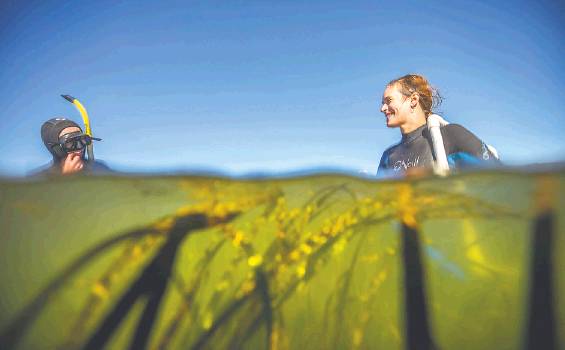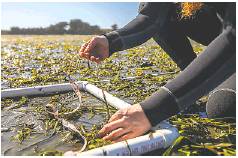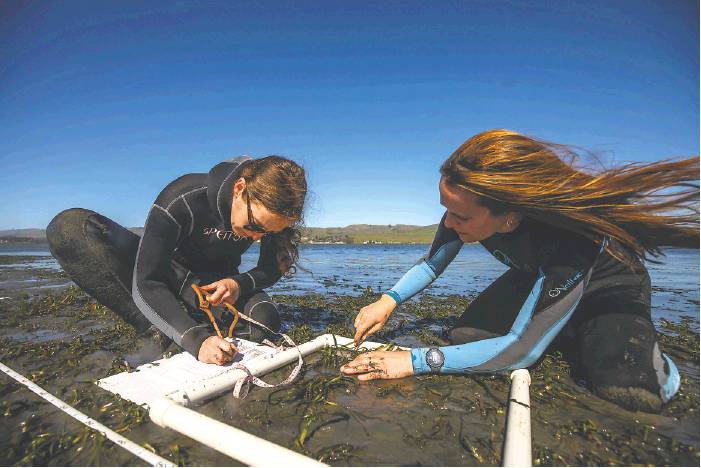Seagrass new hero in climate change fight
Underwater meadows cut acidification, aid shellfish, study shows
By Tara Duggan
Eelgrass, a plant that grows in “underwater meadows” along the California coast and emerges like a floating carpet at low tide, is already known to be an important habitat for fish, birds and baby Dungeness crabs. It turns out it can also reduce seawater’s acidity back to preindustrial levels, creating refuges for animals who can’t tolerate that byproduct of climate change.
That’s the conclusion of a six-year study published recently by the UC Davis Bodega Marine Laboratory. It showed eelgrass meadows in seven California locations decreased ocean acidity by up to 30%. Because acidification, the result of the ocean absorbing increasing amounts of carbon dioxide from the atmosphere, has increased by 30% due to climate change, the plant has the ability to reverse the effects in its habitat.
The report, published in the journal Global Change Biology, is the most extensive study to show seagrass’ long-term ability to ameliorate ocean acidification. Its authors say it shows the importance of protecting seagrass meadows, which have shrunk in number and size globally because of pollution and development, so they may support wildlife as well as the production of farmed oysters, mussels and abalone.
“Because these systems are on the decline in many areas around the world, I would like this research to support many seagrass restoration efforts,” said lead author Aurora M. Ricart of the Bigelow Laboratory for Ocean Sciences in Maine, who was doing postdoctoral research at the Bodega Marine Lab during the study.
From 2014 to 2019, Ricart and her co-authors submerged sensors both inside and outside eelgrass beds at Bodega Harbor, and in Tomales Bay, Elkhorn Slough near Monterey, Newport Bay in Orange County and Mission Bay in San Diego to track their pH levels, salinity, temperature and other conditions. The eelgrass beds buffered — or reduced — acidification for an average of 65% of the time across the locations by absorbing carbon.
Eelgrass is the main type of seagrass on the West Coast. Its ability to reduce acidity could help commercial fisheries because ocean acidification can reduce the ability of young shellfish to add calcium carbonate, which they need to build shells.
Between 2005 and 2009, acidification killed oyster larvae in Pacific Northwest farms by the millions, causing farmers to scramble to find new sources. But because oyster beds can’t be placed right on top of eelgrass meadows, the next step will be to find out how to get the effects of the buffering downstream.
Scientists already knew that eelgrass absorbs carbon dioxide and therefore reduces acidity in the water, but there was skepticism that the effects were long-lasting, said Melissa Ward, a co-author of the study and a postdoctoral researcher at San Diego State University.
“To be able to show that it’s not a matter of hours but weeks is really exciting,” Ward said.
Ward said they chose a range of study locations to include urban harbors and more remote, protected areas. They didn’t see a big difference, however, in the effects of eelgrass on ocean acidity. Also, because plants absorb more carbon as they photosynthesize during daytime hours, the scientists thought that the effect would drop when it gets dark. Instead, it continued into the night.
Eelgrass meadows are already known to prevent erosion and create a habitat for seabirds, as well as fish like salmon and halibut, and a rookery for Dungeness crab and spiny lobster, which face the same problem developing shells in acidic water.
“Some critical species during early life history stages will seek refuge in the seagrass nooks and crannies when they’re more vulnerable,” said Rebecca Albright, curator at California Academy of Sciences, who has studied the effects of ocean acidification on coral reefs but was not involved in the study. “Their ability to offset acidification would make them an even more important refuge, particularly for those crustaceans.”
The state already has efforts in place to protect its eelgrass habitat. The California Ocean Protection Council has a goal of preserving the state’s existing 15,000 acres of seagrass beds and adding 1,000 acres by 2025.
Kathryn Beheshti, a California Sea Grant State Fellow with the Ocean Protection Council, wasn’t part of the study but has done her own research on ocean acidification in Elkhorn Slough, where she is also replanting eelgrass.
“It just validates that investment in these coastal habitats and their restoration, as well as their conservation, is important for many benefits, including acidification buffering,” Beheshti said. “Studies like this that are so comprehensive are going to really help increase or maintain the momentum.”
The benefit of projects like those Beheshti is working on is they allow local governments to combat the effects of climate change even though they don’t have the power to reduce the global emissions that are causing it, Ward said.
Tara Duggan is a San Francisco Chronicle staff writer. Email: tduggan@sfchronicle.com Twitter: @taraduggan



